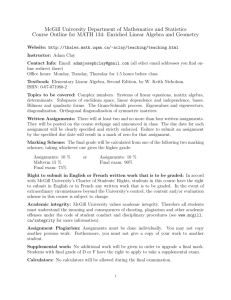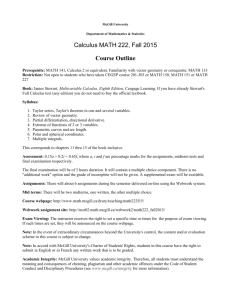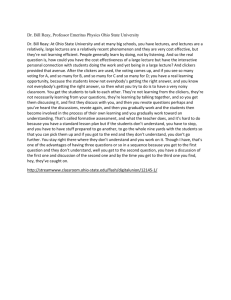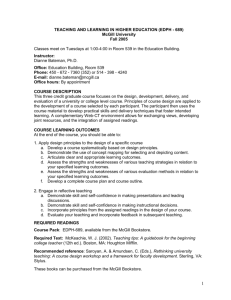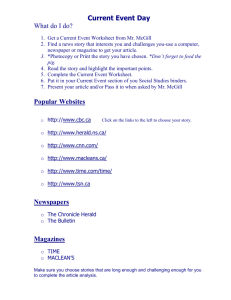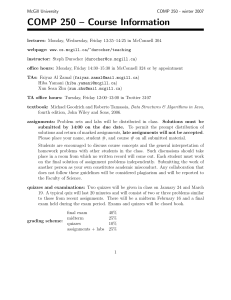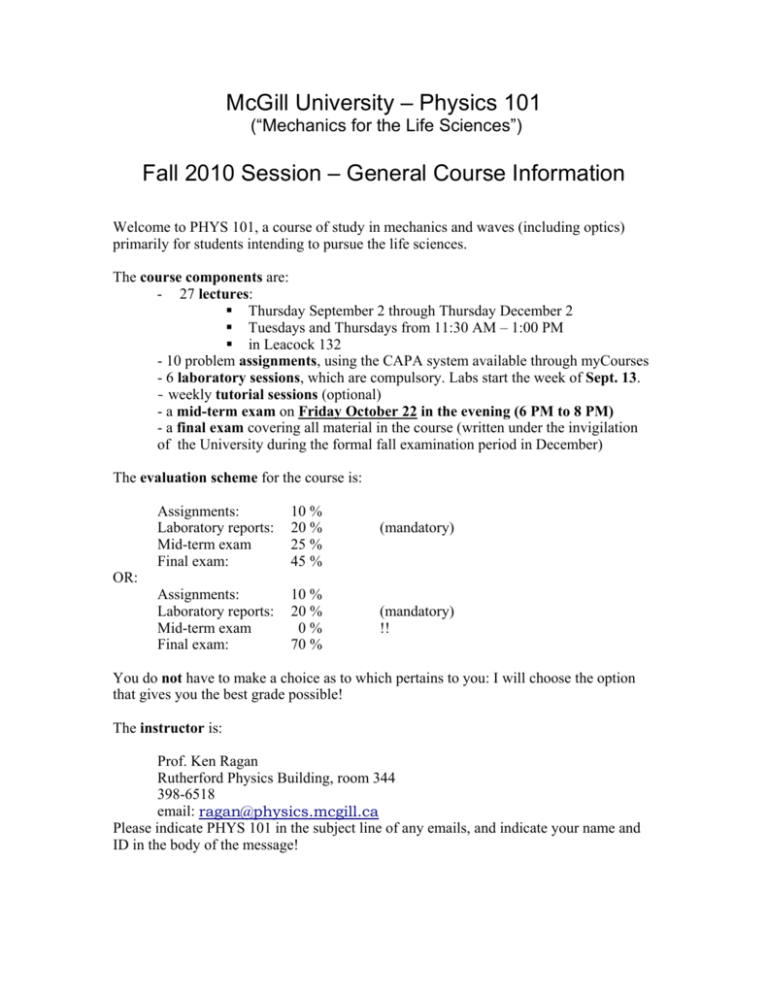
McGill University – Physics 101
(“Mechanics for the Life Sciences”)
Fall 2010 Session – General Course Information
Welcome to PHYS 101, a course of study in mechanics and waves (including optics)
primarily for students intending to pursue the life sciences.
The course components are:
- 27 lectures:
Thursday September 2 through Thursday December 2
Tuesdays and Thursdays from 11:30 AM – 1:00 PM
in Leacock 132
- 10 problem assignments, using the CAPA system available through myCourses
- 6 laboratory sessions, which are compulsory. Labs start the week of Sept. 13.
- weekly tutorial sessions (optional)
- a mid-term exam on Friday October 22 in the evening (6 PM to 8 PM)
- a final exam covering all material in the course (written under the invigilation
of the University during the formal fall examination period in December)
The evaluation scheme for the course is:
Assignments:
Laboratory reports:
Mid-term exam
Final exam:
10 %
20 %
25 %
45 %
Assignments:
Laboratory reports:
Mid-term exam
Final exam:
10 %
20 %
0%
70 %
(mandatory)
OR:
(mandatory)
!!
You do not have to make a choice as to which pertains to you: I will choose the option
that gives you the best grade possible!
The instructor is:
Prof. Ken Ragan
Rutherford Physics Building, room 344
398-6518
email: ragan@physics.mcgill.ca
Please indicate PHYS 101 in the subject line of any emails, and indicate your name and
ID in the body of the message!
The textbook is “Physics” by D. Giancoli, 6th edition, publisher Pearson/Prentice Hall.
Available in the bookstore (~$132) and also in the used textbook market. It will be used
in the winter course PHYS 102 as well. There is also a special McGill edition with just
the material that we use in the course – it’s smaller and slimmer than the full text. It’s got
a green and black cover, and is marked “Custom Edition for McGill University” but the
content (so far as this course is concerned) is identical!
The course material will include large parts of Chapters 1 – 8, 11, 12, 23, 24, and 25
of Giancoli, approximately in the order that Giancoli covers it. The lectures will not
cover the material in the same depth as the text, but instead will briefly cover the material
and then concentrate on problem-solving. Reading the appropriate material from the
text in advance of the lecture will be necessary!
You will need to access course material through the myCourses system
(www.mcgill.ca/mycourses). The site will contain this information, the course schedule,
PDF files of the lecture notes, lecture recordings, the laboratory manual, a link to the
CAPA system that will be used for assignments, and other useful course material.
Lectures will be held in Leacock 132 from 11:35 to 12:55 each Tuesday and Thursday.
Typically I will introduce some new material, try to solicit discussion on the concepts,
then work through some example problems. Please consider the lectures as interactive –
please don’t hesitate to interrupt me if there is something you don’t get!
The lecture notes will be available in PDF format on myCourses, in two different
“versions”: a pre-lecture version without solutions to the in-class examples, and a postlecture version with the solutions (in my sometimes-messy handwriting). In addition, the
lectures will be recorded with a package that includes audio, PowerPoint transparencies,
overhead projector feed (for problem solving) and possibly video; the resulting files are
posted to myCourses (typically within 48 hours after the lecture) and available in
multiple formats.
In the lectures, we will be using a personal response system (“clickers”). Use of the
clickers will be monitored (that is, I record the answers), but will not be graded. The
clickers must be purchased from the University Bookstore (for this course and several
other freshman courses). There are more details about the clickers at the end of this
document.
The assignments, done on the web through the CAPA system (link available through
myCourses), will be available for one week each, with the first assignment starting by
Tuesday September 7. After the one-week time period for each assignment, results will
be posted and there will be no further credit granted. The one-week period will close (ie,
assignments will be due) at midnight Montreal time on Mondays, starting Monday,
September 13 through Monday, November 15 (9 assignments). The final (10th)
assignment will be due Monday November 29 at midnight. Because of the Thanksgiving
holiday (October 11th), assignment #5 will be due one day later than usual, on Tuesday
October 12th at midnight. There will be no assignment for the week prior to the midterm
(that is, there is no assignment due on Monday, October 25th).
The CAPA system allows us to create individual assignments for each student, generally
by randomizing the numbers in the problems. It also allows you to respond multiple times
(usually 6 for problems requiring computation) until the correct response is given. You
will not be docked points for using the multiple chances (that is, you get full marks if you
finally get the question right, even if it takes you 6 tries to do so). The heart of doing
physics is problem-solving; used correctly, the assignments allow you to hone your
problem-solving skills.
Laboratory sessions are in room 0070 in the Wong Building (across from the Rutherford
Physics Building), and reports are to be handed in to your lab demonstrator at the end of
the lab session. Attached you will find a schedule of the course that includes the lab
sessions; they start during the week of September 13. For those having valid excuses
for missing labs (such as illness), there will be a period of make-up labs at the end of the
course; contact the instructor or the head lab TA for details.
The labs are mandatory and you must pass the lab component in order to pass the class.
The labs are meant to provide hands-on experience with some of the phenomena
introduced in the course, as well as a general introduction to the issues of measurement
and uncertainty; they are essential in truly understanding these issues.
Tutorials are offered several times per week for those who would like to have more help.
Tutorial attendance (like class attendance!) is not compulsory. Tutorials give you the
chance to meet with teaching assistants to discuss particular ideas, concepts, or problems
that you may be having trouble with. The tutorial times will be discussed in class and
announced on the web; it will take us a week or so to get them set up.
Both exams will be a mix of conceptual questions (either multiple-choice questions, or
questions requiring short written answers) and problems requiring numerical solutions.
The 2-hour midterm will likely have a few conceptual questions and 3 to 4 problems
(each perhaps with several parts); the 3-hour final exam will have up to 10 conceptual
questions and 5 to 6 problems. The final will be cumulative.
A scientific calculator with trig functions, square roots, and logs is essential for the
course and for the examination. Graphing calculators are fine but this feature is not
necessary (nor, in my opinion, very useful!). A suggested calculator model is the Sharp
510, available for about $11 in the bookstore.
My office hours are on Tuesdays from 2:00 PM to 3:30 PM and on Fridays from 10:30
AM to noon. However, there will be times when I won’t be able to make those times due
to meetings. In general, though, if I'm in my office and my door is open, you're welcome
to knock and I will usually be available to help you. Please do NOT be shy about
coming to see me if you are having difficulties.
I hope you’ve all seen the standard McGill legal warning about academic integrity:
“McGill University values academic integrity. Therefore all students
must understand the meaning and consequences of cheating, plagiarism
and other academic offences under the Code of Student Conduct and
Disciplinary Procedures (see http://www.mcgill.ca/integrity for more
information).”
And finally, a little bit more about the Student Response System (“clickers”). Clickers
will be used in this course to enhance engagement, increase interactivity, and aid you in
evaluating your progress.
New and used clickers are available at the McGill Bookstore, for $50 (new) and about
$35 (used). Purchase only one clicker for all your courses. Only one type of clicker is
authorized for use on campus.
One clicker cannot be shared between multiple students (see Student Code of Conduct,
http://www.mcgill.ca/cio/e-policies/). Doing so is considered an academic offense.
Register your clicker to your McGill ID by going to one of your course in myCourses,
clicking on the link “Register your clicker,” and following the instructions. You don’t
need to do this for each course – once you’ve registered the clicker for one, it will carry
over to your other courses.
Lost clickers must be replaced at your own expense and re-registered using the link in
myCourses.
For verification that a clicker is working correctly, please come to me (after class), or
consult the ICS Service Desk (688 Sherbrooke, room 285) between 9:00 am and 5:00 pm.
For any other questions, please see article #2226 at the IT web page (www.mcgill.ca/it/).
The use of clickers is relatively new for us in Physics 101. We have used them for a few
years, and the response has been very favorable. Their use allows me to understand more
fully if the physics concepts we encounter have been understood. That, in turn, allows me
to tailor the lectures, including the examples I use and the time I spend on them, to
facilitate your understanding. I encourage your feedback on the clickers (and indeed, on
all other aspects of the course!).

